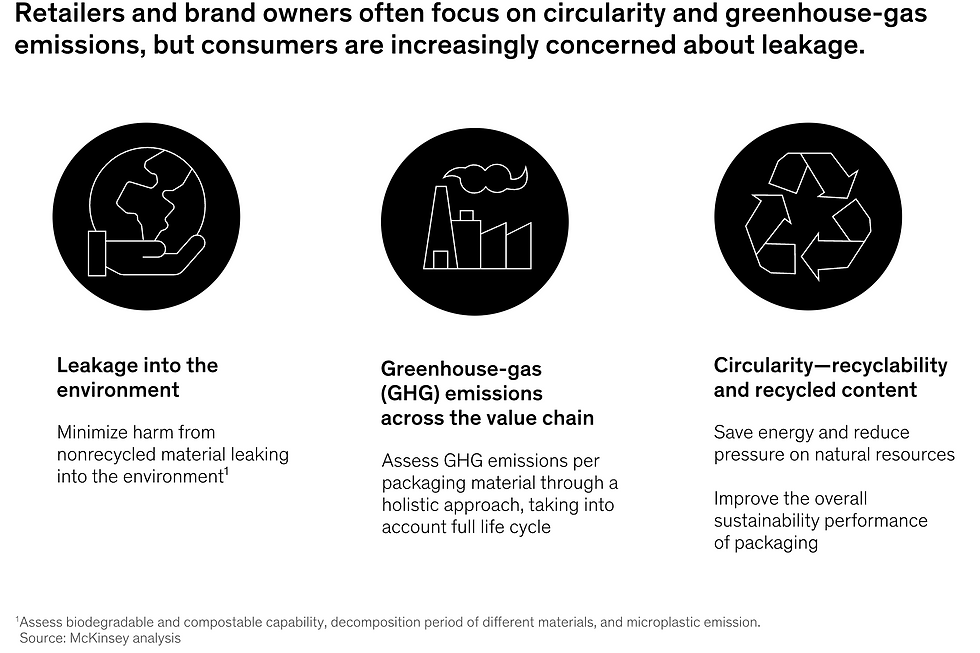
The global sustainable packaging market was estimated to be valued at $263.8 billion in 2022. With an expected growth rate of 5.9% the global sustainable packaging market is expected to reach $351.4 Billion by 2027. Key companies in this market include Amcor Ltd., Ball Corp., Ball Metalpack, Be Green Packaging, Bemis Co. Inc., etc.
What to expect today:
Understanding sustainable packaging
Sustainable packaging at Starbucks, Pepsi and H&M
Sustainable packaging

Sustainable packaging is the development and use of packaging which results in improved sustainability. Sustainable packaging efforts are often centered around a desire to decrease leakage, improve circularity, reduce carbon footprint, or a combination of the three.
Three elements of packaging sustainably
Sustainability in packaging can be broken into the following three main elements:
eliminating leakage of packaging into the environment,
increasing the recyclability in the material of plastics used and use of recycled content in the packaging, and,
reducing the carbon footprint of packaging,

For brand owners and retailers, the focus for packaging has been primarily around circularity—recyclability and recycled content—but there is growing interest in carbon footprint and elimination of waste leakage. Furthermore, it’s important to recognize that all three sustainability elements are interlinked and that, in fact, there are some important trade-offs to consider when thinking about how to optimize overall sustainability in packaging.
Statistics on sustainable packaging
Let us take a look at two relevant use cases: beverage containers, such as those used for carbonated soft drinks, and food-service cups for cold drinks.

Beverage containers’ higher recyclability does not necessarily equal a better carbon footprint. We should look at both the recyclability rate today and its impact on greenhouse gas emissions. Focusing our efforts towards beverage containers (starting from glass and then aluminum) will yield maximum results for the environment.
Although food-service cups’ greater reusability can advance carbon-reduction goals, recycling rates for food-service cups are relatively low across our three example. In terms of direct and indirect carbon footprint, a single-use paper cup has a significantly lower carbon footprint compared with a single-use plastic cup, due to the overall low carbon emissions of producing a paper cup.
Source: Research and Market, McKinsey & Company
Sustainable packaging at Starbucks, Pepsi and H&M
Starbucks

In support of the company’s goal to reduce waste sent to landfill from stores and direct operations, Starbucks is shifting away from single-use plastics, promoting reusability and championing the use of recycled content, driven by a broader shift towards a circular economy. The initiatives include:
offered the option to enjoy the beverage in For Here Ware (ceramic cups in the store) or to BYOC (bring your own cup) for a discount (stopped it due to COVID-19)
reintroduced personal reusable cups and For Here Ware
introduced a Borrow-A-Cup program in stores in Seattle and Korea, which gave customers the option to receive their beverage in a reusable cup and return it at a participating store’s contactless kiosk
developing compostable and recyclable hot cups
eliminating plastic straws
Pepsi

Pepsi's sustainable packaging efforts support the PepsiCo Positive ambition in two ways: striving to build a more circular and inclusive positive value chain by contributing to a more sustainable supply chain for their packaging; and also continuing to evolve their portfolio of food and beverage products by providing positive choices for their consumers with innovative packaging solutions. Their initiatives include:
light-weighted their bottles
reduced thickness of their films
cut down on shipping and other packaging materials
launched “Every Bottle Back” to invest in recycling infrastructure upgrades
identifying new suppliers for recycled PET (rPET), the main plastic used to make beverage bottles
Research efforts:
became a member of NaturALL Bottle Alliance, a research consortium to accelerate the development of packaging made with sustainable and renewable resources
also became a member of Danimer Scientific to develop biodegradable film resins to be used for next-generation snacks packaging
joined Pulpex Limited to further develop and scale the world’s first recyclable paper bottle
H&M

H&M is working to change the way they package their products, what they make their packaging from and what happens to their packaging after it has done its job. The initiatives by the company include:
replaced plastic shopping bags with certified paper options in most stores and introduced a charge in several countries to incentive customers to use their own bags
phased out non-recyclable hangers and replaced them with ones made of recyclable, bio composite that can be reused
eliminated plastic polybags from online deliveries
phasing out mixed materials in gift boxes and packs for our beauty products, removing all the plastic components
shifted from plastic boxes to reusable pouches for make-up tools
Here is a short infographic highlighting H&Ms goals towards sustainable packaging. Their 'reduce, innovate and re-use' model is trying their best to achieve the company's goals by the year 2025 and 2030.

Source: PepsiCo, H&M Group, Starbucks Stories & News
Recommendations from the team
Amcor - Check out a quiz based on Sustainable packaging
Process Minted - Sustainable packaging that thinks OUTSIDE THE BOX...literally! (5 min video)
Goldman Sachs - Unpacking the shift to sustainable packaging (3 min video)
Comments